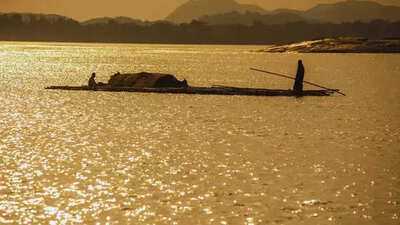
Known as the only ‘male’ river in India, it carries a unique identity rooted in mythology, geography, and cultural significance. But what makes the Brahmaputra male? Why does this mighty river have such an exceptional status? Let’s unravel the fascinating mystery.
The Mythological Origins of the Brahmaputra

Like many Indian rivers, the Brahmaputra has an origin story steeped in mythology. According to Hindu legend, the river is believed to be the son of Lord Brahma, the creator of the universe, hence the name ‘Brahmaputra’ (meaning ‘Son of Brahma’).
The Sage Shantanu and Amogha’s Wish
A popular legend states that a revered sage, Shantanu, was deeply devoted to Lord Brahma. His wife, Amogha, longed for a child, so she fervently prayed to Brahma. Pleased by her devotion, Brahma granted her a boon, and she gave birth to a river—Brahmaputra—who was considered their son. Unlike other rivers that are often associated with female deities, the Brahmaputra's divine lineage as the ‘son of Brahma’ gives it a masculine identity.
The Tale of Lord Shiva and Goddess Parvati
Another legend connects the river to Lord Shiva. It is said that Goddess Parvati’s sweat mixed with the waters of the Kailash region, leading to the birth of the Brahmaputra. This association with masculine energy and divine forces further strengthens the belief in its male identity.
The Geography of a Mighty River

The Brahmaputra is not only unique in its identity but also in its journey. Originating from the Angsi Glacier in Tibet, it flows through China, India, and Bangladesh, covering a distance of approximately 2,900 kilometers. In Tibet, it is called the Yarlung Tsangpo. After entering Arunachal Pradesh, it is known as the Siang before finally adopting the name Brahmaputra in Assam.
The Brahmaputra’s Ever-Changing Nature
Unlike most Indian rivers that follow a steady course, the Brahmaputra is highly unpredictable. It is one of the few rivers in the world that experiences braided channels, drastic course changes, and massive floods during monsoons. This wild, untamed nature aligns with the traditional masculine traits of power, aggression, and dominance, reinforcing its male characterization.
Scientific Wonders of the Brahmaputra

The Brahmaputra is not just a cultural marvel but also a geographical and scientific wonder. Here are some remarkable facts about this river:
One of the Few Rivers with a Tidal Bore
A tidal bore occurs when ocean tides push seawater against a river’s current, causing a sudden and strong wave. The Brahmaputra is one of the very few rivers in the world that experiences this phenomenon.
Home to India’s Largest River Island and Sandbar
The Brahmaputra is home to Majuli, the world’s largest river island, and Umananda Island, the smallest inhabited river island. Both islands attract tourists and spiritual seekers alike.
Massive Water Flow and Volume
With an average discharge of 19,300 cubic meters per second, the Brahmaputra carries one of the highest water volumes of any river in the world. Its powerful flow often leads to widespread flooding, reshaping its banks and altering landscapes.
The Brahmaputra’s Cultural and Economic Significance

The Brahmaputra is more than just a river; it is the lifeline of Assam and the northeastern states of India. It holds immense cultural, economic, and ecological importance.
Religious and Spiritual Significance
The river is considered sacred by Hindus, Buddhists, and indigenous communities. Many temples, such as the famous Umananda Temple on Umananda Island, are built along its banks.
Fertility and Agriculture
The Brahmaputra’s floods, though devastating, bring rich alluvial soil, making the plains highly fertile for agriculture. Assam’s famous tea plantations, rice fields, and mustard crops benefit from the river’s nutrient-rich deposits.
The Role in Trade and Navigation
Historically, the Brahmaputra served as a crucial waterway for trade. Even today, it is an important channel for river transport, fishing, and hydroelectric projects.
The Threats Facing the Mighty BrahmaputraDespite its grandeur, the Brahmaputra faces numerous challenges:
- Climate Change: Rising temperatures are causing glacial melt in Tibet, leading to erratic water levels and flash floods.
- Deforestation and Soil Erosion: Uncontrolled deforestation along its banks accelerates erosion, altering its course frequently.
- Dams and Hydroelectric Projects: China’s construction of dams on the Yarlung Tsangpo has raised concerns in India about reduced water flow and ecological imbalances.
- Pollution: Increasing industrial waste, plastic pollution, and untreated sewage threaten the river’s health.
A River Unlike Any OtherThe Brahmaputra remains one of the most fascinating rivers in the world, carrying the distinction of being India’s only ‘male’ river. Whether viewed through the lens of mythology, geography, or scientific phenomena, it stands apart from all others. With its raw power, dynamic course, and deep cultural roots, the Brahmaputra continues to inspire awe and reverence.
However, with great power comes great responsibility. Preserving the Brahmaputra is crucial not just for India but for all nations that depend on its waters. Understanding its mysteries and respecting its might will ensure that this ‘son of Brahma’ continues to flow for generations to come.
What do you think about this incredible river? Have you ever visited the Brahmaputra? Share your thoughts in the comments!
 Known as the only ‘male’ river in India, it carries a unique identity rooted in mythology, geography, and cultural significance. But what makes the Brahmaputra male? Why does this mighty river have such an exceptional status? Let’s unravel the fascinating mystery.
Known as the only ‘male’ river in India, it carries a unique identity rooted in mythology, geography, and cultural significance. But what makes the Brahmaputra male? Why does this mighty river have such an exceptional status? Let’s unravel the fascinating mystery.



